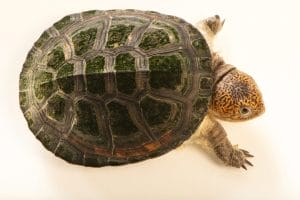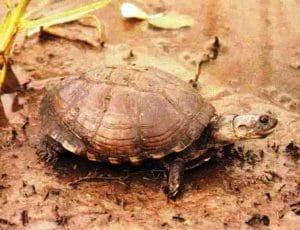Pelusios marani (Gabon mud turtle)
Home > Turtle Database > Pelusios marani (Gabon mud turtle)

Pelusios marani, also known as the Gabon mud turtle, is a lesser-known freshwater turtle species found in parts of Central Africa. It belongs to a group of turtles that spend much of their time in shallow, muddy waters.
Native To These Regions
GabonNative Turtle Species Map – Find Turtles by Region
Scientific Classification
Kingdom: Animalia
Phylum: Chordata
Class: Reptilia
Order: Testudines
Family: Pelomedusidae
Genus: Pelusios
Species: Pelusios marani
Common Names
Gabon mud turtle
Maran’s mud turtle
This Hilarious Turtle Book Might Know Your Pet Better Than You Do
Let’s be real—most turtle care guides feel like reading a textbook written by a sleep-deprived zookeeper.
This one’s not that.
Told from the snarky point of view of a grumpy, judgmental turtle, 21 Turtle Truths You’ll Never Read in a Care Guide is packed with sarcasm, sass, and surprisingly useful insights.
And hey—you don’t have to commit to the whole thing just yet.
Grab 2 free truths from the ebook and get a taste of what your turtle really thinks about your setup, your food choices, and that weird plastic palm tree.
It’s funny, it’s honest, and if you’ve ever owned a turtle who glares at you like you’re the problem—you’ll feel seen.
Identification
Description
This turtle has a dark brown to black carapace with a domed shape. The plastron is lighter and hinged, allowing it to close partway for protection. The head is pointed with light markings around the eyes and jaws.
Sexual Dimorphism
Males tend to have longer, thicker tails and slightly smaller bodies than females. The vent in males extends past the edge of the carapace, while in females, it does not.
Check more turtles from the Pelusios genus
Native Origin and Distribution
Geographical Range
It is primarily found in Gabon, with possible distribution in neighboring countries like Cameroon and the Republic of the Congo.
Preferred Habitat
Pelusios marani lives in slow-moving or still freshwater bodies such as swamps, marshes, and muddy streams. It prefers soft substrates and areas with dense aquatic vegetation.
Behavior
Feeding Habits
It is an omnivore. Its diet includes insects, small fish, aquatic invertebrates, and plant matter. It forages underwater or in shallow water.
Predators
Natural predators include birds, larger reptiles, and some mammals. Eggs and hatchlings are especially vulnerable.
Reproduction
Breeding Season
Breeding likely occurs during the rainy season, but specific timing is not well documented.
Reproductive Method
It lays eggs in nests dug into soft, sandy soil near water. Clutch size and incubation period are not well known for this species.
Conservation
Extinction Status
Not Evaluated.
Threats
Habitat destruction, pollution, and wetland draining pose major risks. Local hunting might also be a factor.
Conservation Measures
Since it’s not well studied, no targeted conservation actions are in place. Protecting wetland habitats is the best indirect support for now.
Economic Importance
It has no major role in international trade. Locally, it might be collected for food or traditional use, but this is not well documented.
Interesting Facts
This species was only described in 2001, making it a relatively recent discovery. Like other Pelusios turtles, it uses a hinged plastron to protect itself when threatened.

About Author
Muntaseer Rahman started keeping pet turtles back in 2013. He also owns the largest Turtle & Tortoise Facebook community in Bangladesh. These days he is mostly active on Facebook.














